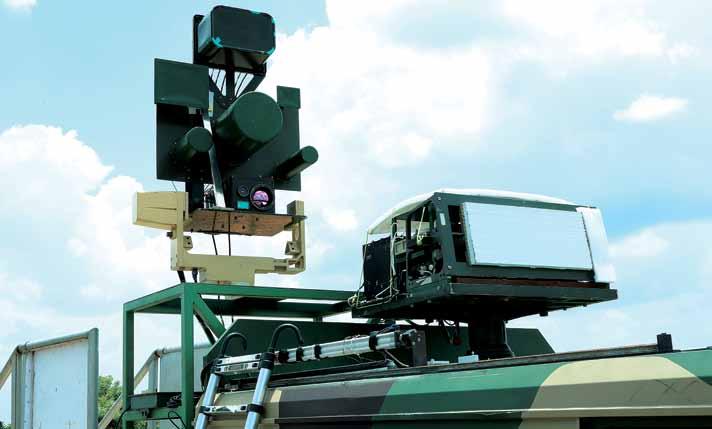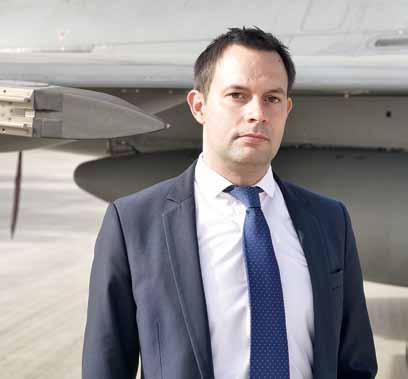
10 minute read
Drones
IndIa’s IndIgenous antI-drone system, developed by drdo and manufactured by bel. the system was deployed for vvIp protectIon dutIes durIng republIc day and Independence day.
DEFENCE AGAINST ATTACK BY ARMED DRONES
Advertisement
By Air MArshAl Anil ChoprA (retd)
A strike by an American drone in the Afghan capital
Kabul in the recent past, prevented another deadly suicide attack at the Kabul International Airport. The strike targeted a vehicle carrying at least one person associated with the Afghan branch of the Islamic State group. Earlier, Azerbaijan successfully used Unmanned Aerial Vehicles (UAV) in its war with Armenia. The United States (US) has been using drone strikes extensively against targets as part of the ‘War on Terror’. The attack by an armed drone on the Indian Air Force (IAF) base in Jammu in June 2021, had brought the national focus on threat from drones. The future is clearly unmanned and the world has been working to counter such threats.
An unmanned combat aerial vehicle (UCAV), can carry ordnance such as missiles and bombs. Till now, most drones have been under real-time human control. However, Artificial Intelligence (AI) technology now supports greater levels of flight and decision making autonomy. There are various ways of tackling threat from drones. The large ones can be engaged by the air defence systems meant for countering attack by aircraft. The smaller drones that are proliferating
across the world, pose a different kind of threat and need different defence approach.
JAMMU ATTACK AND DRONE ATTACK MODALITIES
In June 2021, two small bomb laden drones were crashed into installations at Jammu airbase. One exploded in the open area and second created a hole in the roof of an office building causing minimal damage. Jammu airfield is just 13.5 km from the Pakistan border. The drone may have been launched from Pakistani territory or by some operative in India. There were IAF Mi-17 helicopters and high-end UAVs at the Jammu airbase. None was hit. The fact that a military installation was targeted, is a matter of concern. More drones have been sighted in the area ever since. Pakistan has used drones in the past to smuggle drugs and arms into Punjab and Jammu regions. The number of incidents have been on the rise.
A drone attack is like any military operation. It requires good target intelligence, accurate target coordinates and pictures of the desired impact point. Such information can be obtained from reconnaissance satellites. A drone can be programmed for an autonomous attack and could fly into the target and explode. Alternatively the operative could fly the drone using a data link. The feed from the drone camera could help final targeting.
MILITARY USE OF UAVS
UAVs are gradually taking over all the roles that were in the domain of manned aerial platforms. These include reconnaissance, logistic support, aerial refuelling and weapon delivery, among others. Large military drones can fly at very high altitudes and have long endurance. The Dull, Dirty or Dangerous missions are usually assigned to UAVs. Dull would mean a long boring reconnaissance missions. Dirty missions are those flown in nuclear, biological or chemical environment. Dangerous missions are flown into areas of high air defence environment. Nowadays, drones are also flown in coordinated swarms, to attack or to saturate enemy defences. These could also be flown as a manned-unmanned team, with a manned aircraft coordinating and controlling a large number of drones in the package.
CIVIL AND HOBBYIST DRONES
Small hobbyist aerial drones are an off-the-shelf item sold openly. Some of these could carry a payload of up to 10 kg. These drones could be used for many day-to-day tasks such as delivery of essentials. They are great for aerial photography. They are also used by government departments for policing of traffic, monitoring fires, surveys etc. Therefore, any knee-jerk reaction after a terrorist attack and putting undue restrictions, would be an unreasonable reaction.
DRONE COUNTERING APPROACH
Countering any airborne threat involves three steps namely detection, identification and destruction. Any drone crossing the border must be treated as hostile. Drones flying near designated sensitive installations or no-drone-flying zones, needs reaction. All other drones need to be regulated through a drone policy and other related regulations.
SMALL DRONE DETECTION COMPLEXITIES
Small drones have low radar cross section (RCS) and hence are difficult to detect by conventional radar. They also have low acoustic signature, and may be heard only when they are a very close range. Drones also have none or low smoke or infra-red (IR) signature. Detection would thus be delayed. There are some avian radars designed to detect birds. These have a range of 15 to 20 kilometres and are used mainly to detect bird activities on the approach path of aircraft. Even the IAF has some of these radars that do have limitations in built up areas. Having such radars for all sensitive installations, is not a practical costeffective solution. Drones can be stored and carried in a small suitcase. As such, search and locate operations are complex. Since drones could be flown from rooftops or from small alleys, locating the place of launch is not easy.
DEFENCE AGAINST A DRONE ATTACK
Once declared hostile, a drone can be neutralised by various kinetic and non-kinetic means. It can be shot using a sniper rifle or small arms. There are anti-drone guns that fire a net to entangle and bring down the drone. Lasers or other forms of directed energy weapons could burn or blind the electronics and optical systems of the drone. This energy could also trigger the warhead explosion. Electronic warfare techniques could jam the data/ control links. The drone GPS receiver could also be jammed. Blinding the drone camera would also greatly reduce its capability. The drone swarms are also a real threat. Mass jamming of the interconnecting data-links and barrage of directed energy, are a good counter. Also, a counter-drone swarm can engage a drone swarm. There are thus many ways to neutralise drones.
REGULATION AND DRONE POLICY
Since drones are important daily-life facilitators, excessively curbing their use would mean denying technology to the masses. The drones should first be categorised by weight, range and altitude envelopes. Any drone policy must thus facilitate use of drones, albeit in a regulated manner. No flight permission may be required up to a certain height. Like the rules of the air, there would have to be regulations and control to prevent collision and cater to emergency situations. There could be mandatory takeoff clearance for flight above a stipulated height or in some zones. No-fly zones may be promulgated. Real-time tracking beacon and geo-fencing may be desirable. The Drone Rules 2021 have already been released by the Ministry of Civil Aviation in India. They specify the need for drone certification. Drones can’t be flown in a manner that they endanger the safety and security of any person or property. Each drone must have a unique identification number and be registered like weapons are registered. Remote pilot licence should be mandatory requirement. Drone traffic management would require regulation. There would be need for insurance for third party damage to life and or property caused by a drone.
GET ONBOARD INDIA
As the future is unmanned, India must promote research and development of drones and unmanned systems to remain globally relevant. There is a need to strengthen regulation and control over drones. Air defence procedures have to be evolved. More no fly zones may be designated to make important installations safer. Sensors and weapons against drones should be integrated in the IAF’s Integrated Air Command and Control System (IACCS). With proliferation of drones, inter-ministerial coordination would be important. Local police and Intelligence Bureau (IB) will have to monitor drones more closely. An antidrone force may be created soon. The national drone policy would need continuous evolvement, using global interactions and inputs. To counter risk of embedded malware in drone electronic sensors, there is a need for greater indigenisation of both platforms and sensors. Drones are the future and India must follow a facilitative proactive approach. SP

celebrating indian air Force day during a landmark year
MBDA understands the importance of operational capability to the IAF and has strongly committed to ‘Make in India’ to deliver the best of military equipment to India
By Boris solomiac, MBDA GenerAl DeleGAte InDIA
Indian Air Force day 2021 comes at a special time when
the partnership between MBDA and the IAF has just gotten even deeper with India having received the majority of its new Rafale fighter aircraft.
With Rafale now in the IAF’s inventory, the IAF can also field a new and potent suite of weapons from MBDA. Unquestionably the most famous is the Meteor, the ramjet powered and network-enabled beyond visual range air-to-air missile that is widely recognised as a game changer for air combat. Meteor’s throttle able ramjet engine provides sustained high-supersonic power, making it the only missile able to chase down maneuvering enemies at even the longest of ranges.
No less game-changing for the IAF is the SCALP stealthy airlaunched cruise missile that also forms part of the Rafale weapons package. This potent weapon will give the IAF an unrivalled and flexible tool to conduct deep strike missions at long ranges against even the most protected of hostile targets.
Another MBDA weapon, MICA provides both the Rafale and the newly upgraded IAF Mirage 2000 aircraft with a uniquely flexible approach to air combat. MICA is the only missile in the world featuring two interoperable seekers (active radar and imaging infrared) that makes MICA highly countermeasure resistant and therefore highly effective.
With a strong reputation as a reliable partner that has supported the Indian Air Force for over 50 years, European missile firm MBDA understands the importance of operational capability and sovereignty to the IAF. For these reasons, the company has so strongly committed to ‘Make in India’ to deliver both industrial sovereignty and the best of military equipment to India.
Indian firms now supply key components for key new missiles that are enhancing the combat power of the IAF. For example, Indian industry today provide extensive manufacturing of 15 major sub-assemblies of MICA missile covering various complex technologies such as mechanical, electrical, electromechanical and pyrotechnic items. MBDA continues to deepen its relationship with Indian industry, as seen by the recent formation of a joint venture with long-standing partner Larsen & Toubro to deliver a series of important missile programmes under the ‘Make in India’ category.
The IAF is also getting a major boost with the addition of the ASRAAM as its Next Generation Close Combat Missile. During 2021, MBDA and Bharat Dynamics Limited (BDL) agreed to establish a new facility in Hyderabad to assemble and test this potent air combat missile. With its large rocket motor and clean aerodynamic design, ASRAAM has unrivalled speed and resultant aerodynamic maneuverability and range. ASRAAM gives it a high kinematic capability that delivers superior endgame performance for within visual range air combat. MBDA’s ASRAAM missiles are significantly enhancing the battle capability of India’s Jaguar bombers, giving them unrivalled selfprotection ability and enhanced ability to penetrate hostile airspace. This highly capable weapon could also boost the combat capability of other IAF aircraft.
Working with HAL, integration of the Mistral ATAM system on the Dhruv helicopter and the Light Combat Helicopter (LCH) has been very successfully completed. Key to many of MBDA’s offerings are their ability to be fitted on multiple platforms. By utilising the same weapon across different platforms, not only do extra aircraft benefit from these capabilities, but there are also major cost savings and operational benefits to be found in maintaining common equipment stockpiles, not to mention the training and logistics benefits. For example, utilisation of the Mistral missile on India’s helicopter platforms provides a bridge to their use in a ground based VSHORAD role, where the missile is fully compliant with India’s requirements and outperforms the capabilities of its rivals. SP










